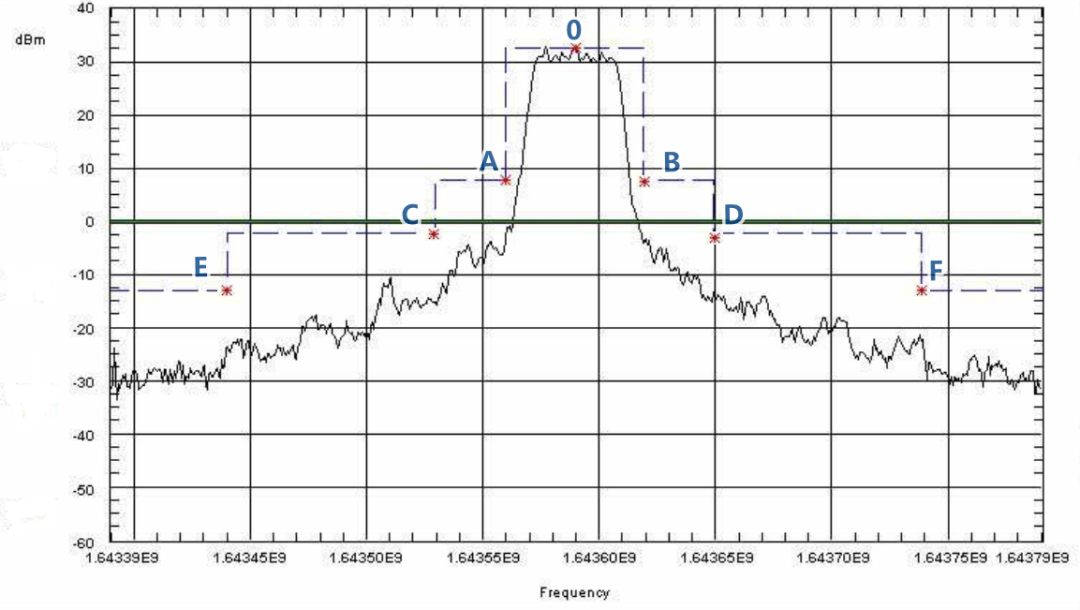

FCC关于频率容限的要求
电子说
描述
今天我们接着来看Part 25.202的频率容差和发射限值。
01
频率容限
(d) Frequency tolerance, Earth stations. The carrier frequency of each earth station transmitter authorized in these services shall be maintained within 0.001 percent of the reference frequency.
(e) Frequency tolerance, space stations. The carrier frequency of each space station transmitter authorized in these services shall be maintained within 0.002 percent of the reference frequency.
以上是FCC关于频率容限(Frequency tolerance)的定义原文。对于地球站和空间站的要求是不同的,分别为参考频率的百分之0.001和百分之0.002,在很多报告上,也往往这样来写:地球站和空间站的频率容差限值分别为10ppm和20ppm,ppm为10^-6,与百分比的表示方法是等效的。其计算公式为(Fmeasured− Freference)/Freference。
Part25.202中只给出了频率容限的技术要求,并没有具体规定测量方法。但我们在一些报告中可以看到,这个频率容限,测量的是载波频率在不同温度和不同供电电压条件下的频率稳定度。例如下表中,温度从-30度~+50度;主电源电压在额定值的±15%之间变化(手提电池设备除外)。

02
发射限值
发射限值分为五个部分:
除了SDARS地面中继器和下面第4点规定的情况之外,应按照以下(1)-(4)规定的模板来进行发射平均功率的调整:
(1) In any 4 kHz band, the center frequency of which is removed from the assigned frequency by more than 50 percent up to and including 100 percent of the authorized bandwidth: 25 dB;
(2) In any 4 kHz band, the center frequency of which is removed from the assigned frequency by more than 100 percent up to and including 250 percent of the authorized bandwidth: 35 dB;
(3) In any 4 kHz band, the center frequency of which is removed from the assigned frequency by more than 250 percent of the authorized bandwidth: An amount equal to 43 dB plus 10 times the logarithm (to the base 10) of the transmitter power in watts;
(4) In any event, when an emission outside of the authorized bandwidth causes harmful interference, the Commission may, at its discretion, require greater attenuation than specified in paragraphs (f) (1), (2) and (3) of this section.
以上是25.202中频谱发射模板的标准原文,不枉我们曾说的,看过FCC的标准之后,还是更希望被3GPP的表格来虐吧。我们使用下面的一张图例来了解一下频谱发射模板限值,就一目了然了:

首先,in any 4kHz band是指我们测试中所用到的测量带宽是4kHz(Measurement bandwidth),图中的0点即为中心频率点(center frequency),(1) 从A点(或对称点B)开始即为将分配的频率除外,从授权带宽的50%开始计算直到100%带宽的C点(或对称点D),限值要求为比0点功率下降25dB;(2) C点(或对称点D)是从授权带宽的100%开始计算直到250%带宽的E点(或对称点F),限值要求为比0点功率下降35dB;(3) 为250%带宽以上频率的限值要求为比0点功率下降43dB+10×log(Tx Power in W);(4)在任何情况下,当授权带宽以外的发射造成有害干扰时,FCC可酌情要求比上述(1)、(2)和(3)段规定的衰减更大。
最后我们再用表格的方式总结一下:

2. 遥测、跟踪和指令信号,也就是我们上次讲到过的TT&C:FCC卫星通信频率划分-Part25.202,可以在指定频段内不在频段边缘的频率上传输,但条件是,与卫星网络上的通信流量相比,这些传输不会造成更大的干扰,也不需要更多的保护来防止有害干扰,或者已经与指定轨道位置6度范围内的授权同频空间站的运营商进行了协调。这里的意思是说TT&C应该不需要测试带外限值。
3. SDARS地面中继器的带外发射限值:首先解释一下SDARS,通常的卫星数字音频广播业务是利用静止轨道通信卫星向地球用户提供相关业务服务,在美国叫做SDARS(Satellite Digital Audio Radio Service):卫星数字音频无线电业务。
(1) Any SDARS terrestrial repeater operating at a power level greater than 2-watt average EIRP is required to attenuate its out-of-band emissions below the transmitter power P by a factor of not less than 90 + 10 log (P) dB in a 1-megahertz bandwidth outside the 2320-2345 MHz band, where P is average transmitter output power in watts.
(2) Any SDARS terrestrial repeater operating at a power level equal to or less than 2-watt average EIRP is required to attenuate its out-of-band emissions below the transmitter power P by a factor of not less than 75 + 10 log (P) dB in a 1-megahertz bandwidth outside the 2320-2345 MHz band, where P is average transmitter output power in watts.
(3) SDARS repeaters are permitted to attenuate out-of-band emissions less than the levels specified in paragraphs (h)(1) and (h)(2), of this section unless a potentially affected WCS licensee provides written notice that it intends to commence commercial service within the following 365 days. Starting 180 days after receipt of such written notice, SDARS repeaters within the area notified by the potentially affected WCS licensee must attenuate out-of-band emissions to the levels specified in paragraphs (h)(1) and (h)(2) of this section.
(4) For the purpose of this section, a WCS licensee is potentially affected if it is authorized to operate a base station in the 2305-2315 MHz or 2350-2360 MHz bands within 25 kilometers of a repeater seeking to operate with an out of band emission attenuation factor less than those prescribed in paragraphs (h)(1) or (2) of this section.
(i) The WCS licensee is authorized to operate a base station in the 2305-2315 MHz or 2350-2360MHz bands in the same Major Economic Area (MEA) as that in which a SDARS terrestrial repeater is located. (ii) The WCS licensee is authorized to operate a base station in the 2315-2320 MHz or 2345-2350MHz bands in the same Regional Economic Area Grouping (REAG) as that in which a SDARS terrestrial repeater is located. (iii) A SDARS terrestrial repeater is located within 5 kilometers of the boundary of an MEA or REAG in which the WCS licensee is authorized to operate a WCS base station.
以上是SDARS的带外发射限值原文,我们同样用表格的方式表示如下:

但却有一些针对SDARS的特殊情况考虑如下:
首先,在以下情况下,允许SDARS中继器的带外辐射超出上述表格规定的水平:即可能受影响的WCS(Wireless Communications Service)持牌人提供书面通知,说明其打算在随后的365天内开始商业服务。但从收到这种书面通知的180天开始,在可能受影响的WCS持牌人通知的区域内的SDARS中继器必须将带外辐射水平降至此表中规定的水平。
其次,如果WCS持证人被授权在2305-2315Hz或2350-2360MHz频段内运营基站,而该距离基站25公里范围内的SDARS中继器,以高于上表中规定的带外发射进行操作,则WCS可能会受到影响。(i)WCS被授权在与SDARS地面中继器所在的主要经济区(MEA)相同的2305-2315MHz或2350-2360MHz频段内运营一个基站。
(ii)WCS被授权在与SDARS地面中继器所在的同一区域经济区分组(REAG)内的2315-2320MHz或2345-2350MHz频段内运营一个基站。(iii) SDARS地面中继器位于MEA或REAG边界的5公里范围内,而WCS许可证持有者在该边界内被授权运营WCS基站。
4. 根据ITU-R通信局收到完整的预先公布信息的日期,在22.55-23.55GHz频段内发射的非对地静止卫星服务中运行的下列无用发射功率限值应适用于23.6-24GHz无源频段的任何200MHz。这里同样是来自于ITU-R的针对无源业务EESS保护的限值要求,但相比于5G NR毫米波基站的IMT频段的要求要更严格。

5. 对于在49.7-50.2GHz和50.4-50.9GHz频段内发射的FSS固定卫星服务(地对空)的地面站,50.2-50.4GHz频段内的无用发射功率不得超过-20dBW/200MHz(在天线输入端测量),但对于天线增益大于或等于57dBi的地面站,最大无用发射功率可提高到-10dBW/200MHz。这些限值适用于晴空条件下。在衰落条件下,地面站在使用上行链路功率控制时可能会超过这些限值。

审核编辑:刘清
-
路灯申请FCC认证机构2015-10-26 3619
-
无线通信FCC认证申请基本的要求2015-10-28 1563
-
FCC 关于射频LED灯的最新认证和测试要求2016-07-25 3036
-
射频LED灯FCC认证的测试要求2016-08-09 3144
-
FCC ID认证基础知识简介2017-09-20 3690
-
QI无线充电器的FCC要求,你了解多少?2018-11-19 1744
-
智能家居FCC认证及测试内容2019-01-09 1283
-
无线麦克风做FCC认证不同频率对应的FCC标准2019-01-21 4006
-
433HZ遥控FCC-ID哪里可以做 遥控器FCC-ID测试有什么要求2021-05-14 972
-
亚马逊美国站要求提供FCC ID认证报告及编号2022-02-23 22484
-
无线充电器美国FCC认证 亚马逊FCC ID注册新要求2022-02-26 578
-
噪音容限,噪音容限是什么意思2010-03-08 4871
-
EMC和美国市场的无线电FCC认证要求2020-05-27 3370
-
北美FCC认证代办理的优势有哪些?需要满足哪些要求?2024-02-04 689
-
北美FCC认证的申请条件:产品技术要求分享2024-09-05 798
全部0条评论

快来发表一下你的评论吧 !

